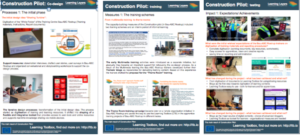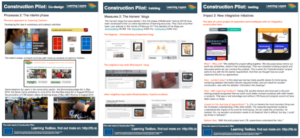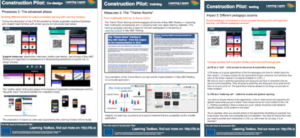In my previous post I started a series of posts on the concluding event of our EU-funded Learning Layers (LL) project - the Final Review. I also explained how we came to the idea to organise the event primarily at the Norddeutsches Zentrum für Nachhaltiges Bauen ((NZNB) - North-German Centre for Ecological Construction Work in Verden, near Bremen). I then gave a picture of the arrangements and the agenda of Review Meeting and how we made use of the spaces provided by the NZNB to present our work in a more dynamic and dialogue-oriented way. In this post I focus on our reporting on the Construction Pilot - what we reported and how we presented our message (taking into account the different arrangements we had prepared before the review panel arrived.
Construction Pilot: Exhibition space and presentation session
We started our contributions with a 'guided tour' round the Exhibition space of the Construction Pilot and the first station was the Poster Wall that presented the story of construction sector pilot activities (with focus on Bau-ABC Rostrup. The poster wall consisted of nine posters that presented the different phases of co-design processes, training measures and emerging impact (the vertical columns). However, when reading the horizontal rows, the story became an integrated picture on mutually supporting activities that paved the way for increasing involvement of the users (Bau-ABC trainers) and demonstrated how they became owners of their own multimedia learning and of the use of Learning Toolbox in vocational training (in their trades and in joint initiatives). Below the screenshots give an impression of the poster wall:
Screenshot 1: Posters on co-design processes, training and expectations at an early phase of the project
Screenshot 2: Posters on progress with co-design, training and using tools in the interim phases
Screenshot 3: Posters on co-design (by users), training results and getting feedback on tools in the advanced phase
At this stage two Bau-ABC trainers - Markus Pape of the carpenters and Stefan Wiedenstried of the road-builders - had joined us and could answer to questions concerning their role in the pilot and on their experiences on using their trainers' blogs and the Learning Toolbox in their training activities. With an additional poster Melanie Campbell highlighted the impact of Learning Layers activities at the organisational level and the steps that Bau-ABC has taken towards shaping its own Digital Agenda. Also, on the follow-up activities she had a separate poster to present the DigiProB project in continuing vocational training as a successor activity.
The exploitation tables: Start-up initiatives and successor projects
The next station in the 'guided tour' were the two exploitation tables. The first one presented the start-up companies that take the work of Learning Layers further on commercial basis. Here, the most important for us is the Bremen-based "stack.services" that has been founded by the developers of the Learning Toolbox (LTB) to support the use of the tool. After the project it will be the main partner for the follow-up activities that will use LTB. In the second table the reviewers got an overview of different UK- and German-based follow-up projects in which LTB is being used. Also, they got information on current talks with companies that want to start using LTB independently of publicly funded projects.
The presentation session: Insights into changing practices in training/learning and into evaluation studies
In the presentation session Lars Heinemann emphasised that the capacity-building in multimedia and web competences needed to get integrated into the pedagogy based on action-oriented learning (Handlungsorientiertes Lernen). He pointed to the evidence already provided by the Bau-ABC trainers. In the subsequent presentation Markus Manhart provided insights into the findings of evaluation studies concerning the following aspects: a) Challenges and barriers, b) Changes in learning and working practices and c) Enhancement of pedagogy in training. Here, the two Bau-ABC trainers could give further examples on their own use of Learning Toolbox and on the impact on the learning behaviour and motivation of apprentices. In the final presentation Thomas Isselhard presented an example on the use of Learning Toolbox in the marketing of good quality construction work in the competition "Grüne Hausnummer" (Green label on the quality of ecological and energy-efficient construction work).
- - -
I think this is enough of the presentations on the construction pilot. Altogether, my impression was that we gave a coherent and genuine picture of serious efforts to achieve results. The contributions from the evaluation studies supported the picture that was given by the application partners and the accompanying researchers - the Learning Toolbox was becoming a tool that was appreciated by the users (alongside the trainers' blogs that emerged as a result of the Multimedia training initiated by the project)- However, for further steps they needed further steps at the level of their own organisations and network partners. Yet, the interested partner organisations were taking initiatives to start their own pilots. Given this picture, we were in a good position to compare the results and learning experiences between the two sectoral pilots.
More blogs to come ...











